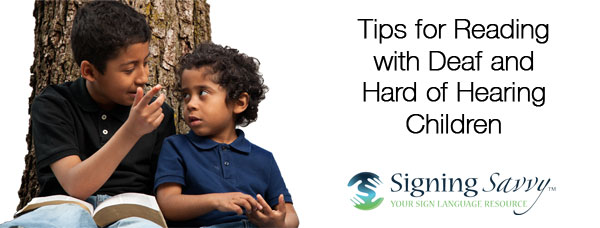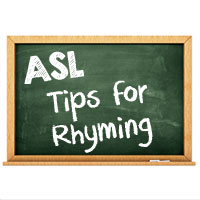
Tips for Reading with Deaf and Hard of Hearing Children
The Importance of Reading with Children
According to the U.S. Department of Education, only 53 percent of children ages three to five are read to daily by a family member.1 Yet, children are significantly better at reading comprehension when parents read with them and encourage reading.2 Children who are read to at home do better in school. Research shows they are better at knowing the alphabet, counting, writing their names, and reading.3 Additionally, the more types of reading materials there are in the home, the higher students are in reading proficiency.4
Motivating children to read is an important factor in student achievement and creating lifelong successful readers. Research has shown that children who are motivated and spend more time reading do better in school.
For more information on Children's Literacy visit the National Education Association website.
Reading with Deaf and Hard of Hearing Children
Over 90% of deaf or hard of hearing children are born to hearing families and there is often a lack of communication between hearing parents and their deaf child. Using sign language when reading increases comprehension, which helps children become more engaged in the story being read and more interested in learning to read themselves.
Parents can use the word list feature on Signing Savvy to create a custom word list of signs that go with a book they are reading. The Signing Savvy quizzing and digital flash cards features can be used to practice the signs from the word list and, of course, it is best to sign while reading the book. This is a way for both parents and children to practice signing together and learn new signs.
Teachers can also create custom word lists of signs that are used from books read at school and then share those word lists with parents. Then parents have great recommended books for signing and reading at home that align with the classroom curriculum.
Some great tips for reading to deaf and hard of hearing children were outlined by David R. Schleper in the publication Reading to Deaf Children: Learning from Deaf Adults. The tips were developed through research of what deaf parents do when reading to their deaf and hard of hearing children.
Schleper's 15 Tips for Reading to Deaf and Hard of Hearing Children
- Translate stories using American Sign Language. Focus on concepts and use lots of fingerspelling.
- Keep both languages (ASL and English) visible. Make sure children see both the signing and the words and pictures.
- Elaborate on the text. Add explanations about the text to make it more understandable.
- Reread stories on a “story telling” to a “story reading” continuum. The first few times, make sure the student understands the story. Then, slowly, focus more and more on the text.
- Follow the child’s lead. What does the child wants to read? What if the child wants to read just one part of a book, then move to another? Follow the child.
- Make what is implied explicit. Make the hidden meaning clear.
- Adjust sign placement to fit the story. Sometimes sign on the page. Sometimes sign on the child. And sometimes sign in the usual place.
- Adjust the signing style to fit the story. Be dramatic. Play with the signs and exaggerate facial expressions to show different characters.
- Connect concepts in the story to the real world. Relate the characters to real events.
- Use attention maintenance strategies. Tap lightly on your child’s shoulder, or give a gentle nudge to keep his or her attention.
- Use eye gaze to elicit participation. Look at the child while reading.
- Engage in role playing to extend concepts. Act out the story after you have read it.
- Use ASL variations to sign repetitive English phrases. If you are using the same phrase over and over, vary the signs.
- Provide a positive and reinforcing environment. Encourage the child to share ideas about the story and support the child’s ideas.
- Expect the child to become literate. Believe in the child’s success and read, read, read!
These tips are from:
- Schleper, D. R. (1997). Reading to Deaf Children: Learning from Deaf Adults. Washington, DC: Laurent Clerc National Deaf Education Center at Gallaudet University. (ISBN 0-88095-212-1)
- They can also be found as part of the webpage on "Reading to Deaf Children" from Gallaudet University's Laurent Clerc National Deaf Education Center.
Resources:
- Laurent Clerc National Deaf Education Center, Gallaudet University. Reading to Deaf Children. Retrieved 2/27/2015 from http://www.gallaudet.edu/clerc_center/information_and_resources/info_to_go/language_and_literacy/literacy_at_the_clerc_center/literacy-it_all_connects/reading_to_students.html
-
National Education Association. Facts about Children's Literacy. Retrieved 2/27/2015 from http://www.nea.org/grants/facts-about-childrens-literacy.html
- U.S. Department of Education, National Center for Education Statistics, from http://www.nces.ed.gov/fastfacts/display.asp?id+56
- U.S. Department of Education. 1996. Reading Literacy in the United States: Findings From the IEA Reading Literacy Study.
- U.S. Department of Education, National Center for Education Statistics, 2000.
- Educational Testing Service, 1999. America's Smallest School: The Family.
ADVERTISEMENTS
 5 Ways for Kids to Communicate Easier with Sign Language This Summer
5 Ways for Kids to Communicate Easier with Sign Language This Summer Tips for Rhyming in Sign Language
Tips for Rhyming in Sign Language







